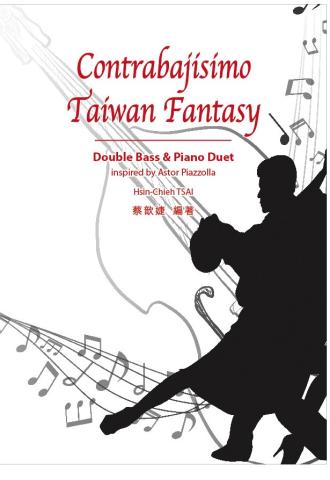《Contrabajisimo-Taiwan Fantasy》為低音提琴及鋼琴
Contrabajisimo意思是『華麗的低音大提琴』,原為Piazzolla特別為樂團裡的低音大提琴手Hector Console而寫作的。這首改編曲是低音提琴與鋼琴的二重奏,開頭的Cadenza已經跟原先TONOS版不同,加入了撥弦技法,並以音域的廣度來呈現不同的氣氛。鋼琴加入後的第一部分,在沒有變動五重奏的樂曲結構下,編進低音提琴的雙音,讓整體音效更為立體。為搭配鋼琴的和聲,低音提琴的部分則巧妙地重複,以台灣著名的歌謠《高山青》其中的旋律,並搭配了Piazzolla類似極限音樂(註1)或是Passacaglia(註2)的寫作手法,完成這個特別的改編曲。
本曲採用了《高山青》的旋律,因此加上Taiwan Fantasy的副標題。
作者改編創作《Contrabajisimo –Taiwan Fantasy》的動機,源於與Circo樂團的演出合作。
註1:極限音樂,Minimal music,是由20世紀初的極簡主義變化而來。在音樂中的寫作手法則為,重複單一動機,以旋律或是節奏來呈現。
註2:Passacaglia technique
Contrabajisimo means “the splendid double bass”, Maestro Astor Piazzolla’s special piece for Hector Console, the double bassist in his band.
The arrangement is for double bass and piano duet. The Cadenza in the beginning is different from the original TONOS. It emphasizes plucking technique in order to display the various atmosphere by enlarging the sounding range. When piano comes in, without changing the quintet structure, add double stops on double bass to enrich the overall sounds.
In harmony with piano, double bass plays the repetition of Taiwan ballad “Mountain Green” with the Minimal Music [1] or Passacaglia technique form resembling what Piazzolla did, weaving some romantic melody, repeating the music section of beginning, and ending with Coda of continuous feverish sixteenth notes.
Subtitle “Taiwan Fantasy” comes from Taiwan ballad “Mountain Green”. Its melody plays an important part in this duet.
Composer TSAI Hsin-Chieh is the double bassist in the Band “Circo”. She was inspired and rearranged “Contrabajisimo -Taiwan Fantasy” when performing with Band “Circo”.
[1] Minimal Music is derived from Minimalism in the early 20th century, based upon the repetition of a single motive, presented in a slow harmonic rhythm.
https://youtu.be/oEhCq7Ld-Gs?list=PLuHFCsBHHyzfr_0o-CQ6agVBIsNCpbhso

